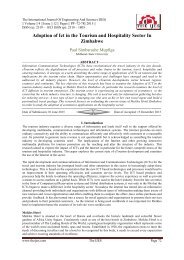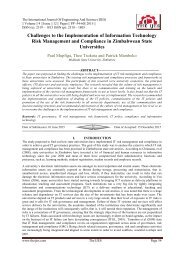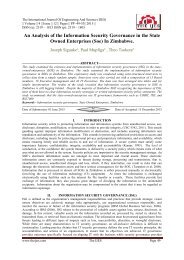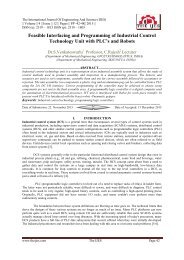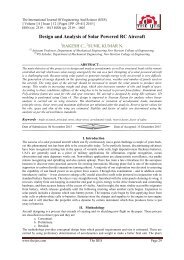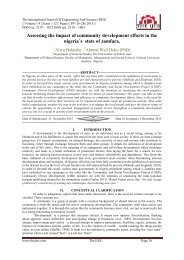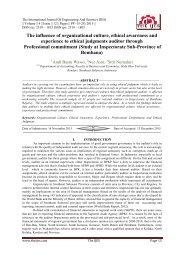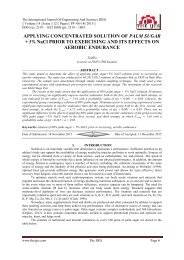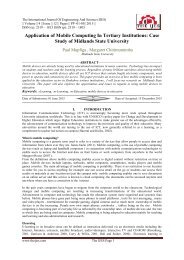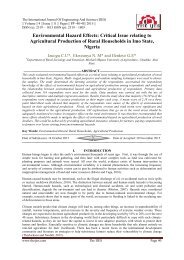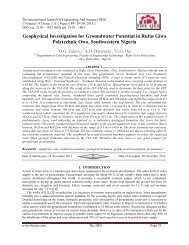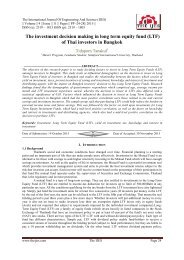Studies on the allelopathic effect of aquatic invasive plants on Cicer arietinum L.
You also want an ePaper? Increase the reach of your titles
YUMPU automatically turns print PDFs into web optimized ePapers that Google loves.
<str<strong>on</strong>g>Studies</str<strong>on</strong>g> <strong>on</strong> <strong>the</strong> Allelopathic <strong>effect</strong> <strong>of</strong> <strong>aquatic</strong> <strong>invasive</strong> <strong>plants</strong> On <strong>Cicer</strong><strong>arietinum</strong> L.<br />
Results displaying <strong>the</strong> <strong>effect</strong> <strong>of</strong> <strong>the</strong> extracts <strong>of</strong> Eichhornia crassipes and Pistia stratiotes <strong>on</strong> <strong>the</strong> radicle<br />
el<strong>on</strong>gati<strong>on</strong> <strong>of</strong> <strong>of</strong> <strong>Cicer</strong> <strong>arietinum</strong> L. (Fig.3&4) recorded its maximum in <strong>the</strong> c<strong>on</strong>trol (24.5cms) <strong>on</strong> <strong>the</strong> sec<strong>on</strong>d day<br />
<strong>of</strong> germinati<strong>on</strong>. The radicle length in .01 ppm treatments in both <strong>the</strong> <strong>plants</strong> did not record any decrease when<br />
compared to <strong>the</strong> c<strong>on</strong>trol. A decrease in length <strong>of</strong> <strong>the</strong> radicle was recorded with increasing c<strong>on</strong>centrati<strong>on</strong>s <strong>of</strong> <strong>the</strong><br />
extract, treatments with extracts <strong>of</strong> E.crassipes,<strong>on</strong> <strong>the</strong> tenth day showed a decrease <strong>of</strong> 28% while it was <strong>on</strong>ly<br />
16% over <strong>the</strong> c<strong>on</strong>trol in treatments with P.stratiotes.The radicle emergence recorded an increase from <strong>the</strong> fourth<br />
day <strong>on</strong>wards. The <strong>allelopathic</strong> inhibitory <strong>effect</strong> <strong>on</strong> seed germinati<strong>on</strong>, radicle (root) and coleoptile development<br />
and root axis producti<strong>on</strong> have been affected adversely (Tasawer et al.2014).<br />
Results displaying <strong>the</strong> <strong>effect</strong>s <strong>of</strong> <strong>the</strong> varying c<strong>on</strong>centrati<strong>on</strong>s <strong>of</strong> <strong>the</strong> extracts <strong>on</strong> <strong>the</strong> growth <strong>of</strong> <strong>the</strong><br />
seedlings did not show any inhibiti<strong>on</strong> with 0.01 % c<strong>on</strong>centrati<strong>on</strong>s <strong>of</strong> both <strong>the</strong> extracts treated. With increase in<br />
c<strong>on</strong>centrati<strong>on</strong> <strong>of</strong> <strong>the</strong> leaf extracts <strong>of</strong> E.crassipes and P.stratiotes, <strong>the</strong> el<strong>on</strong>gati<strong>on</strong> <strong>of</strong> <strong>the</strong> hypocotyl showed a<br />
decrease. Data from Fig. 3 &4 displayed maximum inhibiti<strong>on</strong> <strong>of</strong> 63.6 % (treatment with E.crassipes) and<br />
32.5% (treatment with Pistia stratiotes) in <strong>the</strong> hypocotyls <strong>of</strong> C.<strong>arietinum</strong> <strong>on</strong> <strong>the</strong> 10 th day over <strong>the</strong> c<strong>on</strong>trol. The<br />
plumule el<strong>on</strong>gati<strong>on</strong> was found to decrease with increasing c<strong>on</strong>centrati<strong>on</strong>s <strong>of</strong> <strong>the</strong> extracts which was more<br />
pr<strong>on</strong>ounced in treatments with Eichhornia crassipes than in Pistia stratiotes. Similar results were obtained by<br />
Daniel and Oliver (2003) in a study <strong>of</strong> <strong>the</strong> Garlic mustard (Alliaria petiolata, Brassicaceae) and attributed it to<br />
<strong>the</strong> <strong>allelopathic</strong> interference by garlic mustard. Extracts and residues from leaves <strong>of</strong> lettuce (Lactuca sativa L.)<br />
cultivar “Che<strong>on</strong>gchima”, showed Coleoptile growth to be significantly lowered, when assayed for <strong>the</strong>ir<br />
<strong>allelopathic</strong> <strong>effect</strong>s <strong>on</strong> seed germinati<strong>on</strong> and early seedling growth.A str<strong>on</strong>g reciprocal correlati<strong>on</strong> exist<br />
between <strong>the</strong> c<strong>on</strong>centrati<strong>on</strong> and <strong>the</strong> seedling growth or <strong>the</strong> water c<strong>on</strong>tent <strong>of</strong> <strong>the</strong> crops under study supports <strong>the</strong><br />
dose linked <strong>allelopathic</strong> phenomen<strong>on</strong>. (Ramanathan et al. 2006).<br />
Results displaying <strong>the</strong> <strong>effect</strong> <strong>of</strong> extracts <strong>of</strong> Eichhornia crassipes and Pistia stratiotes <strong>on</strong> <strong>the</strong> chlorophyll<br />
c<strong>on</strong>tent <strong>of</strong> <strong>Cicer</strong> <strong>arietinum</strong> is given in Fig.7 & 8. The total chlorophyll, chlorophyll a and <strong>the</strong> chlorophyll b<br />
c<strong>on</strong>tent recorded <strong>the</strong> highest in c<strong>on</strong>trol and .01ppm treated seeds in both <strong>the</strong> treatments. The total chlorophyll<br />
and <strong>the</strong> chlorophyll a c<strong>on</strong>tent <strong>of</strong> seeds treated with extracts <strong>of</strong> E.crassipes and P.stratiotes showed a marginal<br />
decrease with increase in <strong>the</strong> extract c<strong>on</strong>centrati<strong>on</strong>s.The 4ppm treatment with E.crassipes showed a decrease <strong>of</strong><br />
46.82 % while P.stratiotes recorded <strong>on</strong>ly a 23.44% decrease over <strong>the</strong> c<strong>on</strong>trol. In seeds treated with extracts <strong>of</strong><br />
E.crassipes and P.stratiotes chlorophyll b c<strong>on</strong>tent showed a marginal decrease with increase in extract<br />
c<strong>on</strong>centrati<strong>on</strong> with a maximum reducti<strong>on</strong> <strong>of</strong> 18.64 % recorded in 10ppm diluti<strong>on</strong> <strong>of</strong> E.crassipes. On <strong>the</strong> c<strong>on</strong>trary<br />
in seeds treated with 0.1 ppm c<strong>on</strong>centrati<strong>on</strong> <strong>of</strong> P.stratiotes, ten day old seedlings <strong>of</strong> <strong>Cicer</strong> <strong>arietinum</strong> recorded a<br />
marginal increase (8.5%) in <strong>the</strong> c<strong>on</strong>centrati<strong>on</strong> <strong>of</strong> <strong>the</strong> chlorophyll b. Low c<strong>on</strong>centrati<strong>on</strong> <strong>of</strong> extracts <strong>of</strong><br />
E.crassipes and P.stratiotes enhanced leaf growth comp<strong>on</strong>ents at all <strong>the</strong> growth stages studied. The major watersoluble<br />
allelochemicals also caused reducti<strong>on</strong>s in leaf chlorophyll c<strong>on</strong>tent. They may be resp<strong>on</strong>sible for negative<br />
<strong>allelopathic</strong> <strong>effect</strong>s <strong>of</strong> quackgrass <strong>on</strong> soybean by inhibiting root growth, by altering i<strong>on</strong> uptake and transport,<br />
and by reducing chlorophyll c<strong>on</strong>tent (Baziramakenga et al.1994).The chloroplast block by allelochemicals is in<br />
<strong>the</strong> photosystem II complex. Cinnamic and benzoic acid derivatives alter membrane potential and have several<br />
physiological <strong>effect</strong>s that suggest membrane perturbati<strong>on</strong>s are <strong>the</strong>ir initial site <strong>of</strong> acti<strong>on</strong>.<br />
The Fresh and dry weights <strong>of</strong> 15 day old seedlings for both <strong>the</strong> extracts <strong>of</strong> Eichhornia crassipes and<br />
Pistia stratiotes treatment showed <strong>the</strong> maximum value in <strong>the</strong> c<strong>on</strong>trol and in 0.01% c<strong>on</strong>centrati<strong>on</strong>s (Fig. 9). The<br />
<strong>effect</strong> <strong>of</strong> <strong>the</strong> extracts <strong>of</strong> E.crassipes and P.stratiotes <strong>on</strong> <strong>the</strong> biomass <strong>of</strong> 15 day old seedlings recorded a 37%<br />
decrease in <strong>the</strong> fresh and dry weight in treatment with extracts <strong>of</strong> P.stratiotes with 4 ppm c<strong>on</strong>centrati<strong>on</strong>, while a<br />
marginal decrease <strong>of</strong> 2% was observed in treatment with extracts <strong>of</strong> E.crassipes in <strong>the</strong> above c<strong>on</strong>centrati<strong>on</strong>.<br />
Results showed by Benyas et al. (2010) that low c<strong>on</strong>centrati<strong>on</strong>s <strong>of</strong> Xanthium strumarium shoot had no<br />
significant <strong>effect</strong> <strong>on</strong> <strong>the</strong> germinati<strong>on</strong> percentage, radicle length, plumule and radicle dry weight, total<br />
chlorophyll c<strong>on</strong>tent and chlorophylls a and b c<strong>on</strong>tent. However, treatments with higher c<strong>on</strong>centrati<strong>on</strong>s had<br />
negative <strong>effect</strong>s <strong>on</strong> mean rate <strong>of</strong> germinati<strong>on</strong>, plumule length and seedling dry weight. In <strong>the</strong> present study<br />
0.01ppm c<strong>on</strong>centrati<strong>on</strong> <strong>of</strong> both <strong>the</strong> extracts did not show any inhibiti<strong>on</strong> <strong>on</strong> <strong>the</strong> biomass <strong>of</strong> C.<strong>arietinum</strong>. The<br />
inhibiti<strong>on</strong> <strong>of</strong> seedling growth, singly or in combinati<strong>on</strong>s,correlate with impairment <strong>of</strong> plant-water relati<strong>on</strong>ships.<br />
These phenolic compounds also alter mineral uptake, chlorophyll c<strong>on</strong>tent, photosyn<strong>the</strong>sis, carb<strong>on</strong> flow, and<br />
phytohorm<strong>on</strong>e activities (Einhellig1995).The different resp<strong>on</strong>ses <strong>of</strong> chlorophyllase a and b activities to <strong>the</strong> same<br />
c<strong>on</strong>centrati<strong>on</strong>s <strong>of</strong> allelochemical phenolics suggest that <strong>the</strong>y may be two different enzymes. It is apparent that<br />
<strong>the</strong> three phenolics may enhance <strong>the</strong> activities <strong>of</strong> enzymes, such as chlorophyllase and Mg-dechelatase,<br />
resp<strong>on</strong>sible for <strong>the</strong> Chldegradative pathway (Yang et al. 2004).<br />
www.<strong>the</strong>ijes.com The IJES Page 44



